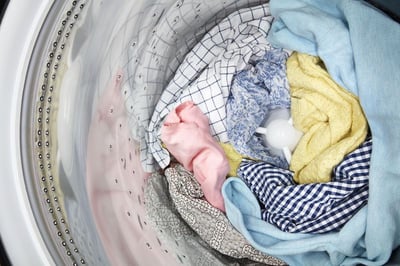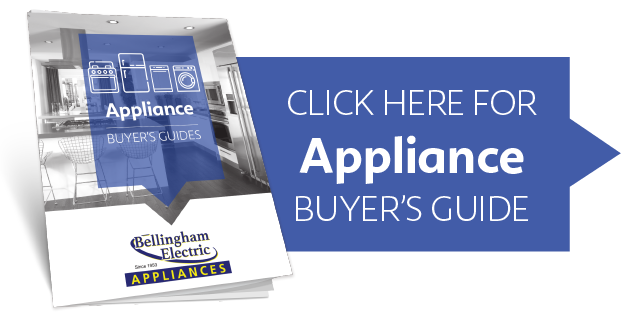
With the new government standards related to water and energy consumption and the popularity of front load washers, the industry has introduced many new top load machines that are designed to compete with front load washers. These machines can offer similar energy savings to front load machines and large capacity wash baskets with no agitators, making them comparable to the front load design. We compare the advantages of disadvantages of HE top load washers compared to front loaders and traditional agitator washing machines.
If you are in the process of researching a new washing machine, you'll want to consider these models - and check out our washing machine buying guide for even more information!
Table of Contents
Overview & Brief History
Terminology:
-
Front load washers: Washers that load from the front rather than the top, with tubs that spin on a horizontal axis.
-
Traditional/Agitator Top Load Washers: The most common washer type before the mid-2000s, with a pole agitator in the center of the tub.
-
High Efficiency/Impeller Top Load Washers: A newer type of top load washer that does not have an agitator and uses less water.
These models use a low-profile impeller that washes clothes by rubbing the fabrics against each other rather than by pushing and pulling them across an agitator pole. Although new washing machine technology is gentler on clothes even when it comes to agitator washers, impeller washers create less wear and tear through the washing action to keep your clothes looking like new for longer.

One point of confusion: some brands will also refer to their agitator washers as HE washing machines. The term "HE" refers to the ultra-concentrated HE detergents that these washers require. If you are looking for a top load washer without an agitator, the term you'll want to memorize is impeller.
The first generation of these new top load machines by GE, Maytag, and Whirlpool was riddled with service and washing problems, but they have since evolved into reliable products with excellent washing performance. Companies like Frigidaire, LG, and Samsung have entered into the market with great products in this design. Today, these products are increasing in their market share and have regained the confidence of the American consumer.
What are the Advantages of High Efficiency Top Load Washers?
-
They are made in the familiar top load design, decreasing the need to bend over when loading and unloading.
-
They have a gentler wash action compared to most agitator washers that is still highly effective.
-
Top load washers are not prone to odors, mold, and mildew as much as front loaders are.
-
They are generally a little less expensive than comparable front load washers.
-
They save water and energy compared to standard top load models.
If you were doing laundry in the 2000s or earlier, you probably had a washer that used a lot of water per wash. It might seem odd that today's top load washers rarely fill the tub to the brim. The wash action has evolved: using less water allows the highly concentrated HE detergents to penetrate more deeply into fabrics to lift stains and soils. While the clothes are churned back and forth, the washing action comes from the friction of the fabrics rubbing against one another and the sides of the tub, rather than from being beat and twisted against an agitator. This is especially beneficial for stretch fabrics (knit t-shirts, leggings, athletic wear, etc) and delicates.
One sign that these new washers are going easier on your clothes: you'll find less lint in the dryer trap. Lint is partly made up of tiny shreds of fabric that are pulled loose in the wash cycle but not rinsed away. When the wash action is gentler, your clothes get clean without undergoing unnecessary wear and tear.
Compare impeller vs agitator washers in our top load washer quick guide!
What are the Disadvantages of a High Efficiency Top Load Washer?
-
High efficiency top load washers have longer wash cycles than traditional top load washers.
-
Clothes must be loaded properly to avoid tangling during the wash cycle - they can't just be thrown into the tub.
-
They are not stackable appliances and therefore can take up more space than front loaders.
-
They generally use a little more water than front loading machines.
-
High efficiency top load washers don't spin quite as fast compared to front loading machines, requiring more time in the dryer. They do, however, spin much faster than traditional top load machines.
Compared to a traditional top load washer with an agitator, washing machine cycle times for impeller washers are usually around an hour (or more for things like Sanitize cycles or extra rinses). They are also more likely to come with more advanced features, such as automatic dispensers for detergent, bleach, and fabric softener, and tend to be somewhat quieter overall. Pricing for these impeller models tends to start at around $700 before holiday sale promotions or rebates kick in. The cheapest agitator washers start at around $480, but if you're in the market for a mid-range washer in the $700 range then you'll see many agitator and impeller models with similar features.
There are many great products in this category ranging in price from $599 to $1,199. They may very well be the best value for most families. Take a good look at these products when you are shopping for your new washer as an alternative to the popular front load format. Check out our review of the best top load washers of the year for some great options to consider!
We hope you've enjoyed this review of the advantages and disadvantages of high efficiency top load washers. Please leave us a comment below. We'd love to hear from you!
Editor's Note: This blog was originally published in March 2015 and has been completely revamped and updated for accuracy as of the publication date noted above.



